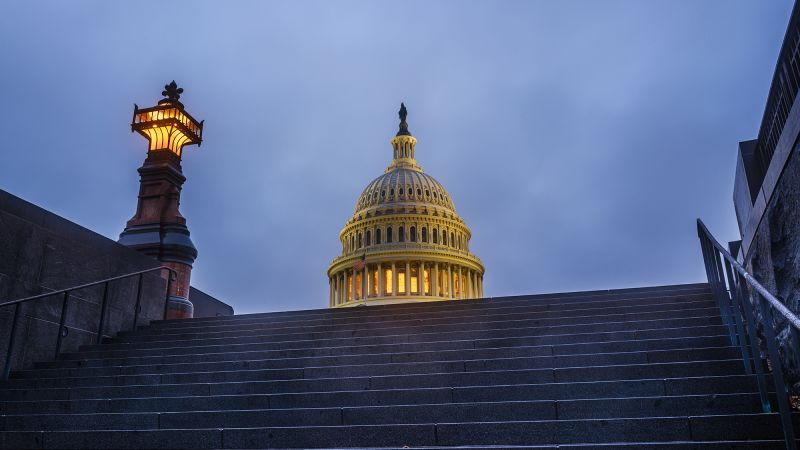CNN
—
Moody’s Ratings downgraded the United States’ debt on Friday, stripping the country of its last perfect credit rating. The move could rattle financial markets and push up interest rates, potentially creating an additional financial burden for Americans already struggling with tariffs and inflation.
Of the three major credit rating agencies, Moody’s was the lone holdout, maintaining its outstanding rating of AAA for US debt. Moody’s held a perfect credit rating for the United States since 1917.
It now ranks US creditworthiness one notch below that, at Aa1, joining Fitch Ratings and S&P, which lowered their credit ratings for US debt in 2023 and 2011, respectively.
The decision to downgrade debt was influenced by “the increase over more than a decade in government debt and interest payment ratios to levels that are significantly higher than similarly rated sovereigns,” Moody’s said in a statement. Moving forward, Moody’s said it expects borrowing needs to continue to grow and for it to weigh on the US economy as a whole.
“The Trump administration and Republicans are focused on fixing Biden’s mess by slashing the waste, fraud, and abuse in government and passing The One, Big, Beautiful Bill to get our house back in order,” White House spokesperson Kush Desai said on Friday. “If Moody’s had any credibility, they would not have stayed silent as the fiscal disaster of the past four years unfolded.”
A spokesperson for the Treasury Department did not immediately respond to CNN.
Moody’s initially put the United States on notice for a potential downgrade in November, at the time citing recent events that exemplified America’s extraordinary political divide. That included America’s near-default last summer and the resulting ouster of House Speaker Kevin McCarthy, the first time in history a speaker was given the boot during a legislative session, and Congress’ inability to cement a replacement for weeks.
Moody’s said the US is is no immediate danger of being downgraded again: The credit-rating agency considers the US outlook “stable” in part because of “its long history of very effective monetary policy led by an independent Federal Reserve.” President Donald Trump, however, has recently raised questions of whether he’d continue to respect the central bank’s independence, and has previously threatened to fire Chair Jerome Powell.
Aa1 is still quite strong, despite its notch below perfect. The ratings agency noted that America’s system of governance, albeit challenged, gives Moody’s confidence that the United States still deserves a near-perfect, if not AAA, credit rating.
“The stable outlook also takes into account institutional features, including the constitutional separation of powers among the three branches of government that contributes to policy effectiveness over time and is relatively insensitive to events over a short period. While these institutional arrangements can be tested at times, we expect them to remain strong and resilient,” Moody’s said.
The credit-rating agency said that increasing government revenue or reducing spending could restore America’s AAA rating. Trump has taken aim at the latter through the Elon Musk-led Department of Government Efficiency, resulting in thousands of federal government workers being laid off and the gutting of the US Agency for International Development (USAID).
However, it’s unclear that such moves are changing the government’s borrowing needs. Already, the country is approaching a summer deadline for when the US could default on its debt unless the borrowing limit is raised, according to Treasury Department estimates.
At the same time, Trump is pushing Congress to pass his “One Big Beautiful Bill Act.”
The package would cut taxes deeply – essentially making permanent the sweeping individual income tax provisions of Trump’s 2017 Tax Cuts and Jobs Act, as well as adding several temporary tax breaks to fulfill the president’s campaign promises.
It also calls for historic cuts to the nation’s safety net – particularly Medicaid and food stamps – in an effort to cut spending.
But the tax revenue loss would still swamp the spending reductions. The package would add $3.3 trillion to the nation’s debt over the next decade, according to a preliminary estimate from the Committee for a Responsible Federal Budget.
Annual deficits would jump from $1.8 trillion in 2024 to $2.9 trillion by 2034 as the federal government would continue to spend more than it would raise in revenue, the committee projected.
Ballooning deficits, the unique US debt ceiling mechanism and political intransigence have been at the center of its downgrades from all three major credit ratings agencies.
In 2011, S&P cited “political brinksmanship” and “America’s governance and policymaking becoming less stable, less effective, and less predictable.” In 2023, Fitch warned of the United States’ “fiscal deterioration,” its “high and growing general government debt burden, and the erosion of governance.”
America was running a $1.3 trillion annual budget deficit in 2011, a number that has since risen to $1.8 trillion last year.
Still, the Obama and Biden administrations lambasted both of those decisions. In 2023, Yellen said the decision was “arbitrary and based on outdated data.”
US debt has long been considered by investors as the safest of safe havens, but Moody’s downgrade, along with Fitch’s and S&P’s suggests it has lost some of its luster.
A downgrade would likely cause US Treasury yields to rise as investors see more risk in lending money to the government.
US Treasuries – and particularly the 10-year US Treasury – influence all kinds of debt, from the mortgage rate for the houses Americans buy to contracts written around the world
This is a developing story and will be updated.

